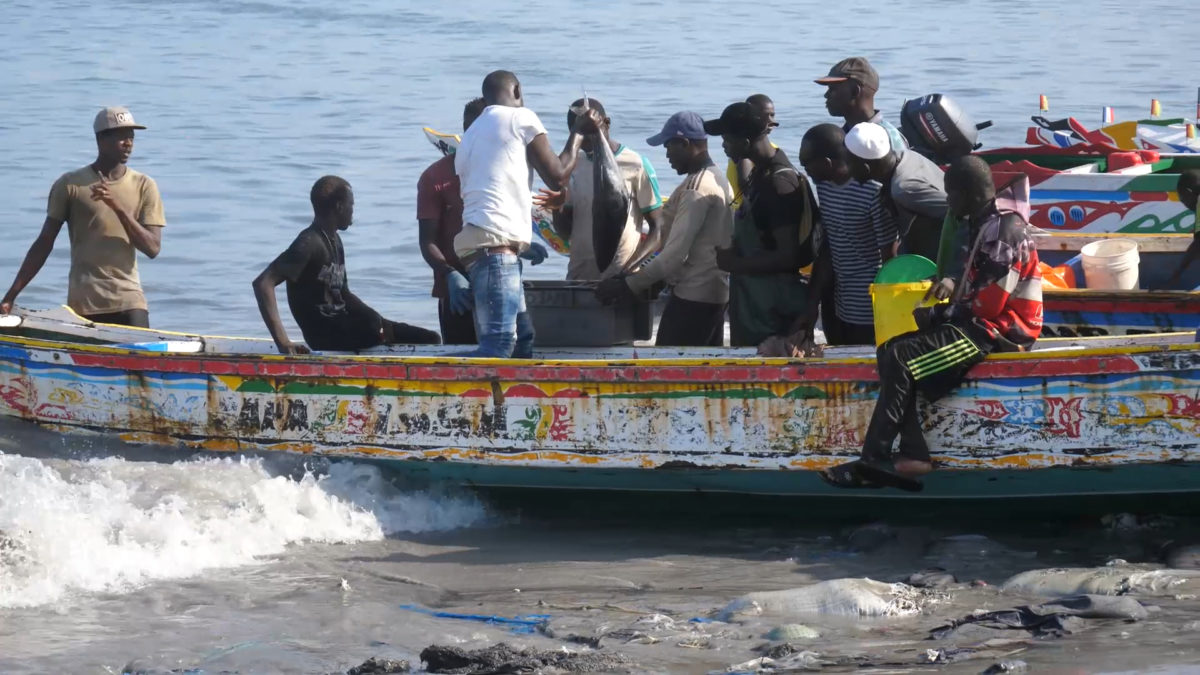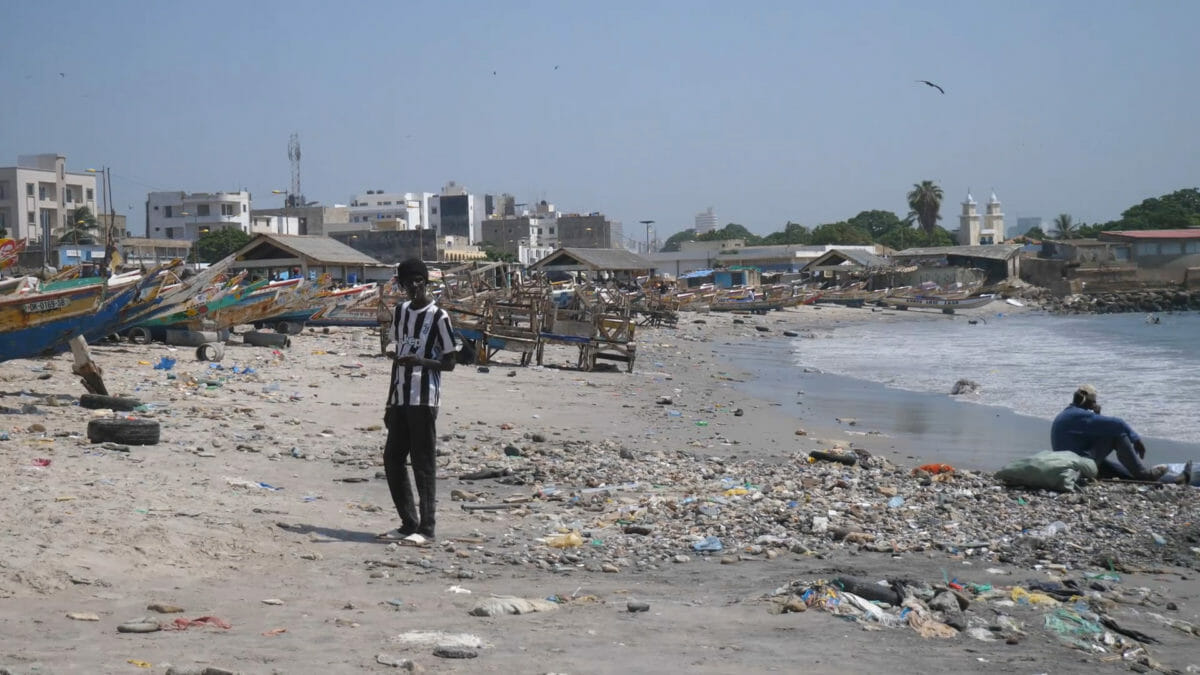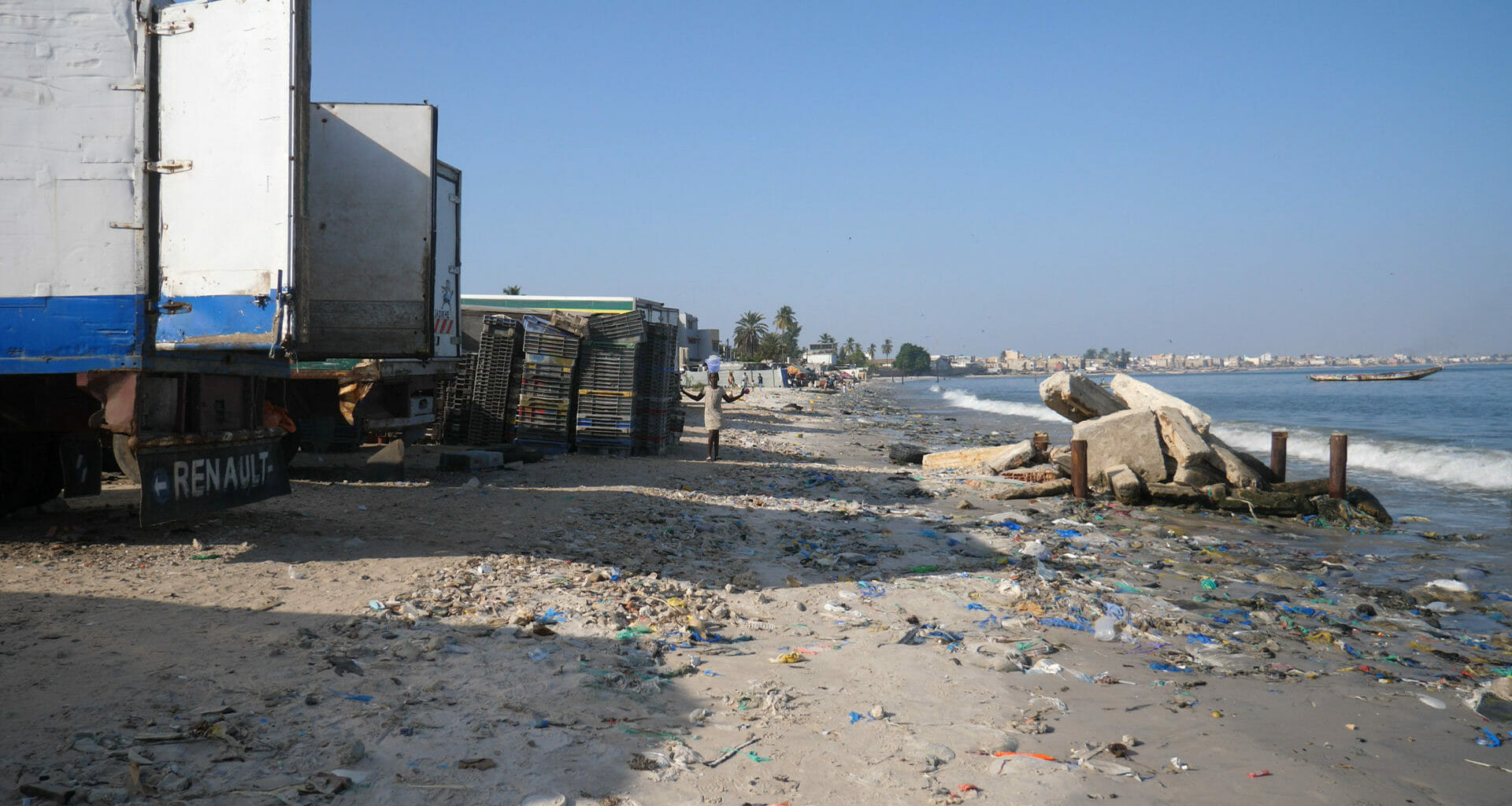The trucks are lined up on the beach, rear doors open towards the ocean. On the sand there are piles of empty crates, and now and then a worker takes one and goes to meet the small coloured pirogues that reach the beach, loaded with fish.
We are at Hann fishing pier in Dakar, Senegal. Pirogues are the typical boats of the Senegalese artisanal fishing, returning with their daily catch, and when one reaches the beach, it is surrounded by people who form a human chain to unload the fish into crates.
Some are sold to the nearby fishing market. Others are loaded onto trucks and delivered to processing factories. Some fish will be frozen and exported while others will reach factories that produce fishmeal and oil, to be exported to Asia and Europe as a component of feed for fish farms.
“We don’t just work with one factory, there are many intermediaries who come here to the beach every evening,” says Adama Thiem, a fisherman from the Soumbédioune fish market in Dakar. “Every intermediary buys fish and takes it to his factory.”
In recent years, the fishmeal industry has been growing fast in Morocco, Mauritania, Senegal and the Gambia, along the migratory routes of Sardinella fish. In 2019 Greenpeace counted 50 fishmeal and fish oil factories operating primarily in Mauritania and more recently also in Senegal and the Gambia – but unfortunately this rapid expansion is causing issues for local people.
“Today we are witnessing a proliferation of fishmeal industries all over West Africa, and this creates several problems”, says Moussa Mbengue, president of the West African Association for the Development of Artisanal Fishing (Wadaf).
“Originally the fishmeal industries had the function of taking fishing waste and manufacturing it. But today there are no more wastes to exploit, because the fish resource is scarce. Consequently, the flour industries no longer use waste, but are fed with small pelagic fish”.
According to the Food and Agriculture Organisation (FAO), small pelagic fish contribute significantly to the economy and food security of both coastal and inland communities in the region, but they suffer a “serious overfishing situation”.
“In countries like Mauritania, Senegal and the Gambia, fishmeal is almost entirely produced from small pelagics — like round sardinella, flat sardinella and bonga — that are usually considered the main and cheaper source of animal protein for thousands of people in the region,” claims Djiga Thiao, technical lead of a 2020 UN study about fishmeal industry and food security.
Kayar fishing village
Kayar is a fishing village 60 kilometres (37 miles) north of Dakar. In 2019 the Spanish company Barna opened a fishmeal factory in the village. The company presents itself as “a small-medium enterprise specialised in fishmeal and fish oil production from by-product” and says it is committed to “sustainability”.
But critics question the claim of sustainability by the fishmeal factory. “All the fishermen sell their fish to the factory,” says Mor Mbengue, Kayar fisherman. “The factory has intermediaries who come to the beach and buy the fish.”
“When the fishmeal factory arrived we were in a programme to restore fish stocks,” claims Mbengue. “The factory encourages overfishing. Even if a fisherman is committed to responsible fishing, he has an incentive to catch juveniles to sell them to the factory.”
According to Babacar Mbodji, another fisherman from Kayar, “there are not much fish anymore”. He adds: “Fishermen catch all kinds of fish, even the smallest ones, not just the big ones, as factories need all kinds of fish to work.”

Local fish processing
A few meters from the beach there is a square, full of stone benches, along with a pile of small fish – sardines – sprinkled with salt. The rest of the square is empty, semi-abandoned.
“At the moment we are not working at all, there is no fish”, says Binta Kama, a female fish processor.
These female fish processors are key figures in the small-scale fishing economy in Senegal. Thousands of women buy freshly caught fish, especially small pelagics, put them in salt or reduce them to powder, in order to supply internal regions that have no access to the sea.
“We work with Burkina Faso or the Togolese,” says Kama. “But in 2020 and 2021 we are no longer able to produce anything at all due to the fishmeal factory.”
“They buy all the fish,” claims Kama, indicating an empty porch behind her. “Twenty of us used to work here, but now there are only four left. The others have abandoned because there is no more work.”
At the Soumbédioune fish market, a fisherman called Adama Thiem says that “working with factories is much better than working with women who sell at the fish market. If you work with factories, you earn more, they pay better.”

Fishmeal export
According to a study by the University of Florida, between four and five kilos of fish are needed to produce one kilo of fishmeal. Commercial data shows that in 2020 Senegal exported 582 tonnes of fishmeal to Europe (worth about £750,000), especially to Denmark (£739,000).
While most fishmeal is exported to China and Vietnam, in 2019 the European Union (EU) was the first destination for Mauritania and Senegal fish oil – France imported 15,100 tonnes from Mauritania while and Denmark bought almost 6,000 tonnes.
According to the European market observatory for fisheries and aquaculture products Denmark is by far the largest EU fishmeal producer, accounting for almost half of European production. The country in 2019 exported 145,000 tonnes of fish oil and 187,000 tonnes of fishmeal, mostly to Norway, Greece and the United Kingdom.
Fishmeal and fish oil are protein ingredients in feeds used in different types of farming, particularly fish farming, in percentages that vary depending on the type of fish.
The campaign group, Compassion in World Farming, says Scottish government data shows that it takes “on average 162-375 wild fish to produce enough fish oil to feed the average Scottish salmon”.
The Scottish Salmon Producers’ Association — which represents the farmed salmon industry in Scotland — says it is fully committed to “sustainably sourced ingredients” and states it does not “currently use feed ingredients sourced from West African fisheries”.
Concerns prevail though. Andrea Doglioli is a researcher at the Mediterranean Institute of Oceanography, who has been working for years in aquaculture plants. He says: “My doubts concern the typical Italian and European aquaculture, where farmers breed predatory fish, such as salmon in Northern Europe or sea bass in the Mediterranean.
“The big risk is maintaining global inequalities,” claims Doglioli. “Perhaps we should think in terms of sustainable aquaculture from a global point of view. Therefore the breeding of carnivorous fish in my opinion is hardly something that could really enter into a green deal.”
This story was produced in collaboration with the One Earth project with the support of the Earth Journalism Network.














